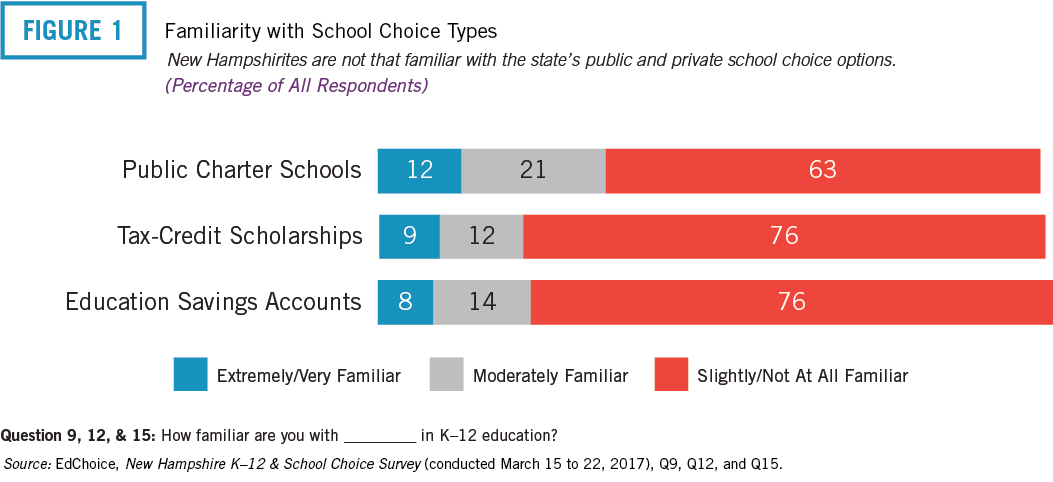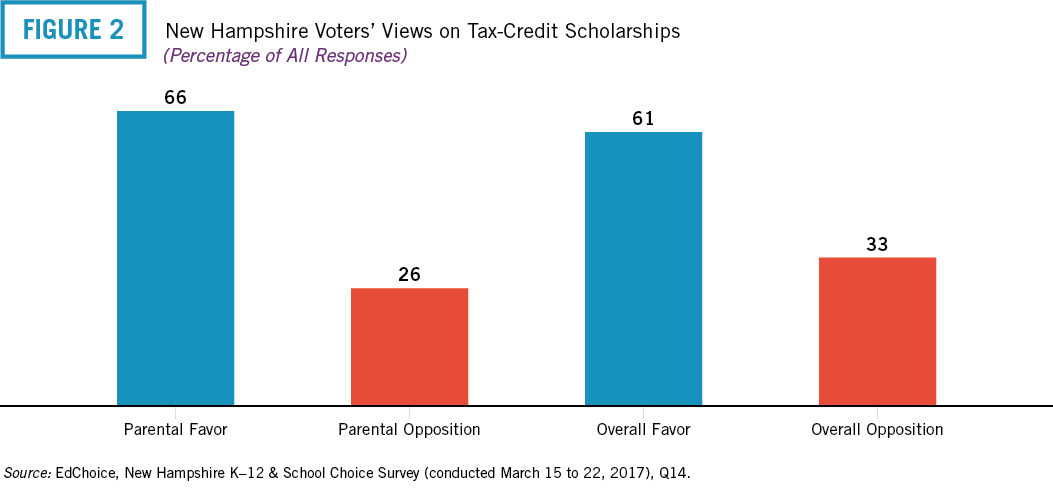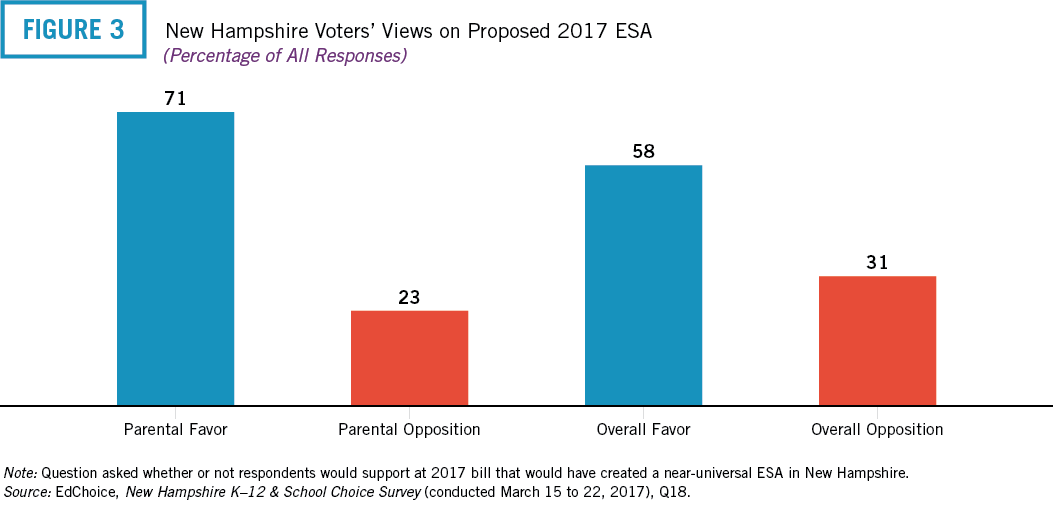Breaking Down New Hampshire’s ESA Bill, the Research and Public Opinion
Last year, New Hampshire legislators introduced a bill to create Education Freedom Savings Accounts. The New Hampshire Senate passed a version of SB 193 that would set up an education savings account (ESA) program that is open to all public and homeschooled K–12 students in the Granite State.
That would be a vast upgrade from New Hampshire’s income-based tax-credit scholarship program, and the result would be a nearly universal educational choice program!
The New Hampshire House Education Committee, however, recommended a considerably scaled-down version of the bill, which the New Hampshire House of Representatives passed last month by a vote on 184-162. Although not as ambitious as the New Hampshire Senate version, the New Hampshire House version would still make significant progress toward providing all Granite Staters with educational choice. The bill is currently under consideration in the New Hampshire House Finance Committee.
The potential program would operate in a similar fashion to ESAs in other states. Here’s how the New Hampshire House Education version of the ESA program would work:
Student Eligibility
Students must be residents of the state who are at least 5 years old but not older than 20 and have not graduated from high school. To enroll in the ESA program for the first time, students must also be currently attending a public school, including a charter school, or be incoming kindergarten students and must meet at least one of the following criteria: (1) have an annual household income less than or equal to 300 percent of the federal poverty guidelines, (2) be assigned to a district school that, for at least two consecutive years, has been deemed by the state to have been “unable to demonstrate that it provides the opportunity for an adequate education” as defined by state law, (3) have an individualized education plan (IEP) or accommodation plan under section 504 of the Rehabilitation Act of 1973, or (4) who applied to and was not admitted to a charter school or who applied for but did not receive a tax-credit scholarship under the state’s education tax credit law.
Although significantly scaled back relative to the New Hampshire Senate’s universal eligibility, the New Hampshire House Education Committee’s version of SB 193 would still likely make more than half of New Hampshire families eligible. The median household income in New Hampshire is $76,260, which is just above 300 percent of the federal poverty line for 2018 for a family of four ($75,300). In addition, students in the later three categories, such as those with special needs, are exempt from the income limits.
Broad eligibility is important to create a critical mass of ESA students over time that will encourage education entrepreneurs to provide new and innovating ways of meeting students’ learning needs. Programs limited to small populations, such as students eligible for the federal free and reduced-price lunch program, tend only to fill empty seats at existing private schools but don’t do much to encourage innovation or even the expansion of existing options.
Student Funding
Accounts may be worth 95 percent (50 percent for incoming kindergarteners) of the state’s per-pupil funding amount plus differentiated aid. For the 2017-18 school year, New Hampshire’s base “adequacy” funding is $3,636 per pupil. Differentiated aid includes $1,818 for low-income students (those eligible for a free or reduced-price lunch), $1,956 for students with special needs, and $711 for English Language Learners. The typical low-income ESA student would therefore receive about $5,450 annually and a low-income student with special needs would receive more than $7,400.
According to Private School Review, the average private elementary school tuition is about $8,900, although 29 schools charge less than $15,000 per year and 15 schools charge less than $6,000. Excluding elite boarding schools and schools dedicated to special education, the average private high school tuition is about $7,560, with some charging as little as $1,525.
In other words, although the typical ESA student would receive only about one-fifth of the $18,216 that New Hampshire district schools spend per pupil, on average, the funding level would still put a wide variety of educational options within reach of the average Granite State family.
Allowable Uses
Funds may be used to pay for:
- Tuition and fees at an eligible in-state public district, charter or private school
- Online learning programs
- Textbooks, curriculum or other instructional materials
- Tutoring services
- In-state community college costs
- In-state higher education expenses
- Fees for testing, including nationally norm-referenced tests, AP exams and college placement exams
- Services for special needs students, including educational therapy
- Transportation (up to $750 per year)
Any unused funds still left in an account at the end of the school year may be rolled over to the next school year, which can continue until a student moves out of state, graduates from college or two years after they graduate from high school if they do not enroll in college.
Regulations
Parents must sign a contract agreeing to provide an education for their student in science, mathematics, language, government, history, health, reading, writing, spelling, the history of the constitutions of New Hampshire and the United States and an exposure to and appreciation of art and music. ESA students must take either the statewide assessment test or a national norm-referenced test. The results of these tests are to be submitted to the scholarship organization administering the ESA program, which then reports the aggregate results to the New Hampshire Commissioner of Education.
ESA-granting organizations must conduct an annual parental satisfaction survey, submit both biannual and annual reports, and undergo an annual audit, but participating schools and educational service providers need only furnish receipts to parents and ESA-granting organizations.
What the Research Says
New Hampshire voters are very supportive of expanding educational choice, and for good reason. These programs are constitutional and fiscally responsible ways to help families provide their children with an education that’s the right fit for their individual learning needs—and parents exercising these options are highly satisfied.
In addition to charter schools, New Hampshire already has two school choice programs—a tax-credit scholarship and a town tuitioning voucher program. A 2017 EdChoice poll found most New Hampshire voters are not familiar with the various school choice options that the state provides (or is considering adopting) …

… but they are strongly supportive of them when informed about them.

Support was especially high among New Hampshire school parents, who expressed strong support for ESAs (71 percent) and tax-credit scholarships (66 percent). It’s no wonder that parents of school-aged children are the most supportive of choice, given the high level of satisfaction among scholarship families.

The state’s Education Tax Credit Program was launched 2013. It has 332 students and 51 schools participating, according to the most recent data, with an average scholarship value of $2,148. Each year, the state’s two scholarship-granting organizations must submit reports to New Hampshire’s department of revenue. Somewhat unique to New Hampshire, these reports detail parental satisfaction with the program (see page 3 here and here).
These reports show parents are tremendously satisfied.
In 2017, 93 percent reported being satisfied or strongly satisfied with the school their children were attending using tax-credit scholarships. A similar figure (91 percent) said their children had “seen a measurable improvement in academic achievement” due to the scholarships. It is worth nothing that 84 percent of families would have been unable to send their children to the schools of their choice had it not been for tax-credit scholarships.
Although the legislature clarified the legality of town tuitioning last year, a recent report from the Granite Institute shows that the practice of towns using public funds to support resident children at private schools dates at least as far back as 1792.
In conjunction with EdChoice, the Granite Institute also published a primer on ESAs. Additionally, the Josiah Bartlett Center for Public Policy published a fiscal analysis of the New Hampshire Senate version of SB 193, which finds that if 1 percent of students left their district schools to accept an ESA, the districts would keep more than 99.8 percent of their budgets. The Josiah Bartlett Center also teamed with the Institute for Justice to publish a legal analysis that explains why a publicly funded ESA would pass constitutional muster in New Hampshire.
Finally, be on the lookout for an upcoming EdChoice survey of New Hampshire private schools. It will explore enrollment and capacity information, familiarity with the tax-credit scholarship program, regulatory concerns and openness to the possible education savings account program, among other issues facing private schools in the Granite State.
New Hampshire has the opportunity to lead the nation in expanding personalized learning options to a wide swath of students. As we at EdChoice have stated before: it’s time for all New Hampshire families to live free and choose their children’s education.





